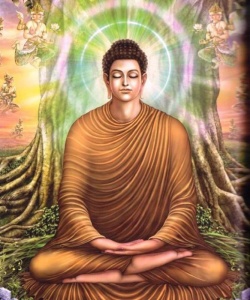Pratyekabuddha
A Pratyekabuddha (Sanskrit: प्रत्येक बुद्ध) or Paccekabuddha (Pāli: पच्चेकबुद्ध), literally "a lone buddha", "a buddha on their own" or "a private buddha",
is one of three types of enlightened beings according to some schools of Buddhism.
The other two types are the Śrāvakabuddhas and Samyaksambuddhas. Pratyekabuddhas are said to achieve enlightenment on their own, without the use of teachers or guides, according to some traditions by contemplating the principle of dependent arising.
They are said to arise only in ages where there is no Buddha and the Buddhist teachings (Sanskrit: dharma; Pāli: dhamma) are lost. Many may arise at a single time.
Unlike Supreme Buddhas (see bodhi), their enlightenment is not foretold.
Some schools assert that pratyekabuddhas are not omniscient, while others say that they are the same (in realisation) as Bodhisattvas, but do not have the will to teach the entire Dharma.
The Mahayana schools considered the Pratyekabuddhas to be self-centred and contrasted them unfavourably with the Bodhisattva.
According to the Theravada school, after rediscovering the path on their own, Paccekabuddhas are unable to teach the Dhamma, which requires the omniscience and supreme compassion of a Sammasambuddha, and even He hesitates to attempt to teach.
Pratyekabuddhas do give moral teachings, but do not bring others to enlightenment. They leave no saṅgha as a legacy to carry on the Dharma.
Pratyekabuddhas (e.g. Darīmukha J.378, Sonaka J.529) appear as teachers of Buddhist doctrine in pre-Buddhist times in several of the Jātakas.
The experiences and enlightenment verses uttered by Pratyekabuddhas are narrated in the Khaggavisāna-sutta of the Sutta Nipāta.
The yāna or vehicle by which pratyekabuddhas achieve enlightenment is called the pratyekayāna, the "on-one's-own vehicle", in Mahayana tradition.
Source
Pratyekabuddhas (Skt.; Tib. rang sangyé; Wyl. rang sangs rgyas), or 'solitary realisers', are followers of the basic vehicle who attain the level of a pratyekabuddha arhat by themselves, in solitude.
They first hear the teachings of the Buddha, then study and reflect upon the twelve links of interdependent origination, and accumulate merit for a hundred kalpas.
They pray to be reborn in a world to which no buddha has come, and they attain realization without relying on a teacher.
They usually teach visually rather than verbally; for example, by displaying miracles such as transforming the upper part of their bodies into fire, and the lower part into water.
'Intermediate Buddhas'
They are sometimes referred to as 'intermediate buddhas' and their enlightenment is considered to be a higher form of realization than that of shravakas for two reasons: their accumulation of merit, and their accumulation of wisdom.
The shravakas accumulate merit for up to sixteen lifetimes, whereas pratyekabuddhas accumulate merit for a hundred kalpas.
In their accumulation of wisdom, shravakas only realise one type of selflessness – the selflessness of the individual – whereas pratyekabuddhas also realise half of the selflessness of phenomena.
For the same reasons, the pratyekabuddhas' realization is considered inferior to the full enlightenment of those following the bodhisattva path.
A bodhisattva accumulates merit for three countless aeons and fully realises both types of selflessness.
Types of Pratyekabuddha
There are two kinds of solitary realisers:
Alternative Translations
Footnotes
- ↑ They are called ‘parrot-like’ because they remain together in groups, unlike the ‘rhinoceros-like’ pratyekabuddha arhats who stay by themselves.
